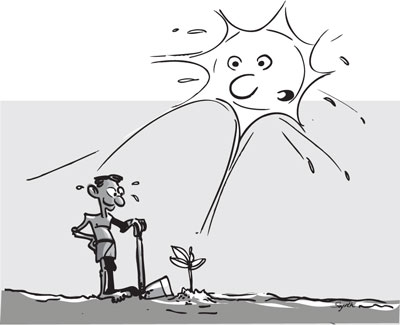Reply To:
Name - Reply Comment
Last Updated : 2024-04-19 22:36:00
In most countries, young people especially are being encouraged and given incentives to find creative, eco-friendly solutions to various dimensions of the climate change crisis. Though the United States President Donald Trump is still insisting that climate change is a Chinese hoax, his ideas may have been drowned in the catestrophic floods, which have hit Houston and other Texas cities for the past weeks with weather experts describing it as the worst in US history.
One major area of creative and innovative eco-solutions is fresh water. Experts say that almost 75% is used for agriculture and in many countries they are developing what is described as dry land farming. 
Paddy cultivation is known to require more water than other crops. With rice being part of Sri Lanka’s culture and civilization for thousands of years, it’s important for Sri Lanka to find creative and innovative ways of using less fresh water. Our young irrigation engineers and technologists need to move into the creative enterprise of finding eco-friendly ways of paddy cultivation.
According to Indian newspaper reports, in many States people have taken up dry land paddy farming. For instance, Kochi had a greener past when a large portion of the present city centre was wetland. Till a few decades ago, these wetlands were used for paddy farming. But they eventually yielded to the pressures of urbanisation and were reclaimed by concrete jungles. The bustling city areas of Panampilly Nagar and Vyttila were once paddy fields where the only mode of navigation was country craft. Canals separated the vast extent of green fields. The attempt to popularize dry land paddy farming has received a good response. The programme is seen as a significant step towards attaining food safety and controlling the price of rice.
Dry farming is not to be confused with rain-fed agriculture which refers to crop production that occurs during a rainy season. Dry farming, on the other hand, refers to crop production during a dry season, utilizing the residual moisture in the soil from the rainy season, usually in a region that receives 20 inches or more of annual rainfall. Dry farming works to conserve soil moisture during long dry periods primarily through a system of tillage, surface protection and the use of drought-resistant varieties.
Dry farming has a long history. Particularly in the Mediterranean region, crops such as olives and grapes have been dry farmed for thousands of years. Even today, vast swaths of Spain Greece, France, and Italy dry farm these crops and in some regions of Europe it is illegal to irrigate wine grapes during the growing season, under the contention that the water will dilute the quality of the grapes.
The production of some of the finest wines and olive oils in the world is accomplished with dry-farmed fruit. The famous California wines that won the Paris Wine Tasting were dry farmed. Today, California has dry-farmed vineyards up and down the coast, from Mendocino in the north, Sonoma, Napa to San Benito, San Luis Obispo and Santa Barbara on the central and south coast. There are a few old dry-farmed vineyards remaining in Lodi and the Sierra foothills, particularly Amador County. In addition to wine grapes and olives, a wide range of crops including tomatoes, pumpkins, watermelons, cantaloupes, winter squash, garbanzos, apricots, apples, grains, and potatoes are at times dry farmed in California, websites say.
Dry farming is not a yield maximization strategy; rather it allows nature to dictate the true sustainability of agricultural production in a region. David Little, a Sonoma vegetable grower who says he at times gets only a quarter of the yield of his competitors, describes dry farming as “a soil tillage technique, the art of working the soil; starting as early as possible when there is a lot of moisture in the soil, working the ground, creating a sponge-like environment so that the water comes from down below, up into the sponge. It is down with a roller or some other implement to seal the top, so that the water can’t evaporate and escape out.
With the National Unity Government accelerating its strategic development programme we hope modern technology would be used to promote dry land farming in Sri Lanka also because experts say the world may face a serious shortage of fresh water in the coming decades.

Add comment
Comments will be edited (grammar, spelling and slang) and authorized at the discretion of Daily Mirror online. The website also has the right not to publish selected comments.
Reply To:
Name - Reply Comment
On March 26, a couple arriving from Thailand was arrested with 88 live animal
According to villagers from Naula-Moragolla out of 105 families 80 can afford
Is the situation in Sri Lanka so grim that locals harbour hope that they coul
A recent post on social media revealed that three purple-faced langurs near t